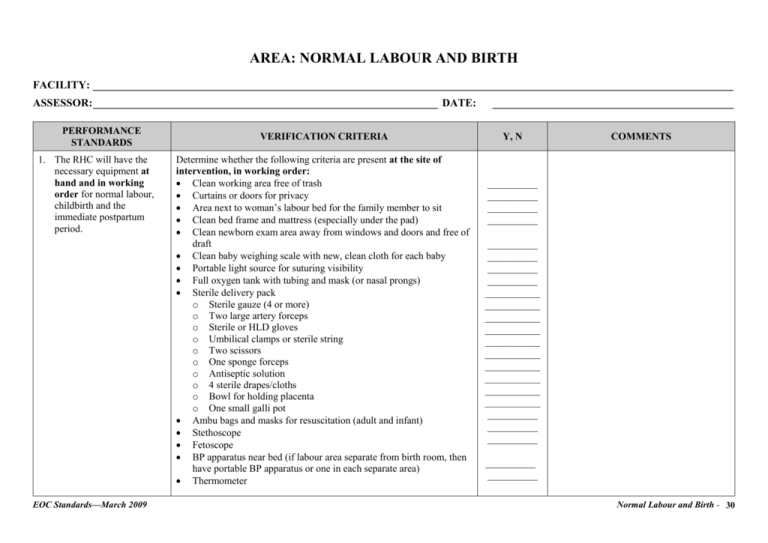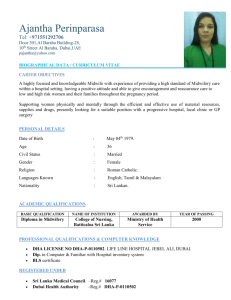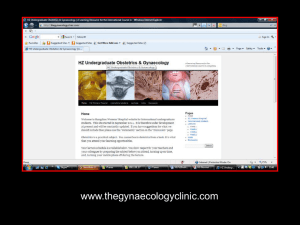Normal Labour Birth
advertisement

AREA: NORMAL LABOUR AND BIRTH FACILITY: _____________________________________________________________________________________________________________________ ASSESSOR: _______________________________________________________________ DATE: PERFORMANCE STANDARDS 1. The RHC will have the necessary equipment at hand and in working order for normal labour, childbirth and the immediate postpartum period. EOC Standards—March 2009 VERIFICATION CRITERIA Determine whether the following criteria are present at the site of intervention, in working order: Clean working area free of trash Curtains or doors for privacy Area next to woman’s labour bed for the family member to sit Clean bed frame and mattress (especially under the pad) Clean newborn exam area away from windows and doors and free of draft Clean baby weighing scale with new, clean cloth for each baby Portable light source for suturing visibility Full oxygen tank with tubing and mask (or nasal prongs) Sterile delivery pack o Sterile gauze (4 or more) o Two large artery forceps o Sterile or HLD gloves o Umbilical clamps or sterile string o Two scissors o One sponge forceps o Antiseptic solution o 4 sterile drapes/cloths o Bowl for holding placenta o One small galli pot Ambu bags and masks for resuscitation (adult and infant) Stethoscope Fetoscope BP apparatus near bed (if labour area separate from birth room, then have portable BP apparatus or one in each separate area) Thermometer ____________________________________________ Y, N COMMENTS __________ __________ __________ __________ __________ __________ __________ __________ ___________ ___________ ___________ ___________ ___________ ___________ ___________ ___________ ___________ ___________ __________ __________ __________ __________ __________ Normal Labour and Birth - 30 PERFORMANCE STANDARDS VERIFICATION CRITERIA 2. Personnel conduct a rapid initial assessment of the pregnant woman at the first contact (admission or shift change). EOC Standards—March 2009 Disposable gloves in all areas Closed container for disposing needles/syringes o Container is disposed of properly when ¾ full o Empty container nearby and ready to replace full one Medications available at site (not expired): o Oxytocin, o Ergometrine o Lidocaine IV tubing and IV solutions available at intervention site Partograph and pen for recording vital signs and interventions Clock Functioning sink or bucket of water with faucet and soap Bucket with 0.5% chlorine solution; bucket with soapy water Plastic covered bucket for contaminated waste Covered placenta bucket with 0.5% chlorine Determine, on visits, whether the provider: Greets the woman Asks the woman if she is currently experiencing any of the following: o Vaginal bleeding o Ruptured “bag of waters,” and if so, time and colour o Respiratory difficulty o Fever o Severe headache/ blurred vision o Severe abdominal pain o Convulsions/loss of consciousness Assures immediate attention for any of the above signs Asks for the woman’s antenatal card or other information if available about the history of this gestation Y, N COMMENTS __________ __________ __________ __________ __________ __________ __________ __________ __________ __________ __________ __________ __________ __________ __________ ___________ ___________ ___________ ___________ ___________ ___________ __________ __________ Normal Labour and Birth - 31 PERFORMANCE STANDARDS VERIFICATION CRITERIA Y, N COMMENTS Attending Normal Childbirth – First Stage 3. The provider assures a supportive environment for the labouring woman EOC Standards—March 2009 Determine whether the provider completes each of the following: Explains all procedures, seeks permission, and discusses findings with the woman and/or her female companion Respects the woman’s wishes to the best possible extent Asks her to wash her perineal area with soap and water Encourages the woman to empty her bladder Allows the woman to sit, stand and move around often in labour Assures privacy from the other patients Encourages a female companion to give support during labour (rub the back, apply wet cloths, assist her to the toilet, etc.) Does not give an enema Encourages her to eat and drink juices or other nutritious drinks as desired Helps her through her pain, gives encouragement and praise, and informs the woman about the progress of her labour __________ __________ __________ __________ __________ __________ __________ __________ __________ __________ Normal Labour and Birth - 32 PERFORMANCE STANDARDS 4. The provider correctly conducts a physical exam. EOC Standards—March 2009 VERIFICATION CRITERIA Determine whether the provider completes each of the following during the physical exam: Washes hands with soap and water and air dries or uses alcohol hand rub Takes the woman’s vital signs (BP, pulse, resp, temp) With one hand lightly on the uterus, times the number and duration of contractions in 10 minutes Determines the lie with Leopold’s manoeuvre Determines descent of foetal head by abdominal palpation Listens to the FHS for one full minute. If foetal distress suspected (FHS < 120 or > 160), turns mother on her left side, applies oxygen per nasal prong/mask at 6L per minute, and calls another provider to confirm diagnosis Asks permission and does a vaginal exam with sterile gloves between contractions Confirms absence or presence of membranes: o Verifies intact amniotic membranes or, if ruptured, when and what colour/odour Confirms cervical dilation quickly and efficiently: o Confirms presenting part and position Rinses gloved hands in 0.5% chlorine; disposes of gloves Washes hands with soap and water and dries them or uses alcohol hand rub Helps her to sit up or roll over off her back after the vaginal exam Informs the woman of the exam findings Advises the woman to take nutritious liquids and to empty her bladder frequently Records all information on Partograph if in active labour (i.e. more than 4cm dilated), or in progress notes if not in active labour Y, N COMMENTS __________ __________ __________ __________ __________ __________ __________ __________ __________ __________ __________ __________ __________ __________ __________ Normal Labour and Birth - 33 PERFORMANCE STANDARDS 5. A written record exists of how the labour is monitored (Partograph). VERIFICATION CRITERIA Verify whether the provider correctly uses the Partograph: Records name, date, time, gravida, para, hospital number, hour or date of ruptured membranes and time/hour of beginning of 4cm (or more), dilation for beginning of monitoring Records cervical dilation on alert line for first exam Records cervical dilation for each vaginal examination every four hours unless indicated sooner Records descent of presenting part every four hours Records moulding and status of membranes every four hours Records contractions and their intensity every 30 minutes Monitors pulse every 30 minutes and records with a dot Monitors BP every 4 hours and records with arrows Monitors temperature every 4 hours Monitors FH every 30 minutes (for full minute each) Records any drugs given (route, dose and time) Y, N COMMENTS __________ __________ __________ __________ __________ __________ __________ __________ __________ __________ __________ Attending normal childbirth – Second Stage 6. The provider prepares for the birth and demonstrates infection prevention practices. EOC Standards—March 2009 Determine whether the provider performs each of the following: Conducts a rapid initial assessment on any new patient who presents to the DHQH in second stage of labour Assures a supportive environment for the labouring woman Conducts a quick and efficient physical exam if possible before the pushing phase Encourages the woman to assume any position she wants to give birth, maintaining safety and cleanliness Places clean plastic drape/cloth under her buttocks Puts on personal protective barriers (eye protection, closed shoes and cover gown or apron) Washes hands with soap and water and air dries Opens the delivery set without contaminating the contents of the pack Puts on Sterile gloves Explains to the woman all actions, comforting/encouraging her __________ __________ __________ __________ __________ __________ __________ __________ __________ __________ Normal Labour and Birth - 34 PERFORMANCE STANDARDS 7. The provider avoids harmful practices during the birth. VERIFICATION CRITERIA EOC Standards—March 2009 COMMENTS Observe whether the provider: Encourages the woman to assume any position she wants to 8. The provider correctly assists the birth of the baby. Y, N give birth, maintaining safety and cleanliness Avoids massage of the vagina and perineum Avoids fundal pressure Encourages mother to push ONLY when she feels the urge Does not perform episiotomy unless: o Frank breech or shoulder dystocia o Foetal distress (FH below 100 per minute for more than 20 seconds) Determine whether the provider performs each of the following: Monitors FH every 5 minutes except when pushing: o Holds fetoscope with sterile gauze to prevent contamination of gloves For birth of the head, the provider: o Gently supports the perineum with one hand and maintains flexion of the baby’s head with the other o Allows the head to crown slowly, encouraging the mother to rest between contractions o Once the head is delivered, asks the mother not to push o Checks for cord around the neck: If loose, slips it over the baby’s head or births the head through the cord If tight, clamps/ties the cord in two places and cuts it o Allows the baby’s head to rotate spontaneously (hands off) For birth of the body after internal rotation, the provider: o Places one hand on top of head, one hand underneath, to support the expulsion of the anterior shoulder first, then the posterior o Supports the body with both hands as it slides out o Places the baby on a sterile cloth over the mother’s abdomen and dries the baby briskly to stimulate crying Clamps and cuts the umbilical cord Ensures baby is warm, in skin-to-skin contact with mother, and head and back covered with another dry cloth __________ __________ __________ __________ __________ __________ __________ __________ __________ __________ __________ __________ __________ __________ __________ __________ __________ __________ Normal Labour and Birth - 35 PERFORMANCE STANDARDS VERIFICATION CRITERIA Y, N COMMENTS Attending normal childbirth – Third Stage (Active Management) 9. The provider properly delivers the placenta using Active Management of the Third Stage of Labour (AMTSL). EOC Standards—March 2009 Determine whether the provider performs each of the following: Asks the woman to assume a semi-reclining position Gently palpates the abdomen through sterile cloth to determine presence or absence of another foetus (if twins, do not proceed with AMTSL) Explains to the woman that she will give a dose of oxytocin and what that is for Administers 10 units of oxytocin IM in the thigh within 1min after birth Places needle in instrument tray by bedside until able to place needle and syringe in puncture-proof container Re-clamps forceps higher up on the cord near the perineum Places one hand over the sterile towel just above the woman’s pubic bone and stabilises the uterus by applying counter pressure (push) during the controlled cord traction (CCT) Maintains traction on the cord and awaits a strong uterine contraction (2-3 minutes) When the contraction is felt, gently pulls down and out on the cord while maintaining counter-pressure on the uterus If the placenta does not descend during the 30-40 seconds of CCT, does not continue to pull on the cord, but waits With the next contraction, repeats the CCT and delivers the placenta Holds the placenta in both hands and twists/turns it gently to tease out the membranes Places the placenta in a bowl at the bedside for further examination Immediately tells the woman that she is going to massage her uterus, and then massages the abdomen over the uterus (with hand over the sterile cloth on the abdomen) to help uterus contract Carefully examines the placenta for completeness Assures the uterus is fully contracted before stopping massage Explains to the woman that she is going to examine her perineum and vagina __________ __________ __________ __________ __________ __________ __________ __________ __________ __________ __________ __________ __________ __________ __________ __________ __________ Normal Labour and Birth - 36 PERFORMANCE STANDARDS VERIFICATION CRITERIA 10. The provider ensures a safe, comfortable environment for the woman and the baby. 11. The provider demonstrates correct infection prevention practices following the birth. EOC Standards—March 2009 Gently, thoroughly examines the perineum and vagina for tears Explains her findings to the woman’s companion Explains the need to suture any tears, if necessary Rinses gloved hands in 0.5% chlorine, removes gloves and puts them into 0.5% chlorine Washes and dries hands and puts on another pair of sterile gloves Proceeds to suture tears, as needed, using sterile technique Determine whether the provider performs each of the following: Assures the mother’s and baby’s vital signs are stable during the cleanup and/or suturing Places clean, new pad over the perineum and asks the mother to tell the provider how often she changes the pads from now onwards Assures safety and comfort of the mother and baby Assists the mother in putting baby to breast as soon as possible, within the first hour of birth Determine whether the provider performs each of the following: Removes all soiled linens and places them in appropriate containers for blood-contaminated linens Places all disposable sharps in puncture-proof containers Places all instruments in a bucket of 0.5% chlorine solution for 10 minutes and then into soapy water for washing Cleans her eye protectors and apron with 0.5% chlorine solution Rinses gloves with 0.5% chlorine and then places them in 0.5% chlorine solution for 10 minutes Washes hands with soap and water and dries them Records all interventions in the chart/register and the Partograph Y, N COMMENTS __________ __________ __________ __________ __________ __________ __________ __________ __________ __________ __________ __________ __________ __________ __________ __________ __________ Normal Labour and Birth - 37 PERFORMANCE STANDARDS VERIFICATION CRITERIA Y, N COMMENTS Immediate postpartum care (first two hours after childbirth) 12. The provider assures a supportive environment for the immediate postnatal period (at first contact or at shift change). EOC Standards—March 2009 Determine whether the provider completed each of the following: Asks the woman how she feels and explains the need for a rapid initial assessment (if this woman is unknown to her or has come into the DHQH after childbirth) Explains all procedures and discusses findings with the woman and/or her companion Encourages woman to bathe or wash when she can Advises the woman of the importance of an empty bladder and checking to make sure uterus is firm (i.e. teach her to massage) Assures privacy from the other patients during examination Assures the presence of a family member, if the woman wants Encourages her to eat and drink nutritious drinks as soon as possible Assures her that postnatal contractions are normal and offer measures to reduce the pain (Ponstan 500mg, Paracetamol (two tablets) PO q6h or prn) Records the woman’s subjective information on her chart/register __________ __________ __________ __________ __________ __________ __________ __________ __________ Normal Labour and Birth - 38 PERFORMANCE STANDARDS 13. The provider conducts a postpartum physical exam. EOC Standards—March 2009 VERIFICATION CRITERIA Determine whether the provider completes each of the following: Washes hands with soap and water and dries them or uses alcohol hand rub Puts on clean examination gloves Monitors the woman’s vital signs every 15 minutes for the first 2 hours, then every 30 minutes for one hour (BP, pulse, resp and fundal height and firmness, bleeding and number of pads used) Monitors the baby’s vital signs every 15 minutes for the first 2 hours, then every 30 minutes for one hour (apex/heart rate and resp, stump condition for bleeding and whether baby is latching on and suckling) Removes gloves and disposes in contaminated waste container Washes hands with soap and water or uses alcohol hand rub Explains all findings to the mother (including newborn exam) Assures baby is feeding well and emphasizes the importance of exclusive breastfeeding for 6 months and weaning advice after 6 months Records all findings in the mother’s chart/register Y, N COMMENTS ____________ ____________ ____________ ____________ ____________ ____________ ____________ ____________ ____________ Normal Labour and Birth - 39 PERFORMANCE STANDARDS 14. The provider assesses the woman and newborn prior to discharge. VERIFICATION CRITERIA Y, N Determine whether the provider: Counsels the mother and companion regarding danger signs and informs her what to do if she has any of those danger signs: For mother: o More than normal amount of vaginal bleeding o Respiratory difficulty o Fever o Severe headache/blurred vision o Severe abdominal pain o Convulsions/loss of consciousness __________ __________ __________ __________ __________ __________ For newborn: Total of standards o Any bleeding in the baby, especially umbilical stump o Any breathing problems with the baby o Any unusual coloured skin (yellow or blue) o Any suckling problems (problem with nipples or baby’s suck) o Any high-pitched or unusual cry Counsel on importance of exclusive breastfeeding for 6 months and weaning advice after 6 months. Counsels on importance of hygiene for her and baby Counsels on the importance of eating well and resting Counsels on options for family planning Counsels on safest time to begin sexual relations again Counsels about importance of immunizations for this baby and her other children Counsels mother to bring the baby for a newborn visit within one week Assures LHW home visit within the first week PP (if possible) COMMENTS __________ __________ __________ __________ __________ __________ __________ __________ __________ __________ __________ __________ __________ 14 Total observed Total achieved EOC Standards—March 2009 Normal Labour and Birth - 40







